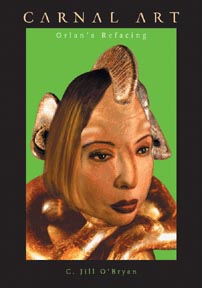The work of the French artist Orlan defies facile description, but in her book Carnal Art: Orlan's Refacing (2005), author C. Jill O'Bryan does an admirable job of discussing the artist's work and its conceptual foundations in a style that is both scholarly and accessible.
Although Orlan has been working with photography and performance art since the 1960s, it is her series The Reincarnation of St. Orlan, begun in 1990, that has drawn the most attention and debate. In this series, plastic surgery became the method and Orlan's own tissue the medium as she underwent a series of operations to appropriate the features of various Western art-historical icons of feminine beauty, ranging from Botticelli's Venus to da Vinci's Mona Lisa. Orlan orchestrates the surgeries, arranging costumes and decorations, and because she undergoes only local, rather than general, anesthesia, is also an active participant in the "performances." Her most ambitious and well-known surgery-performance, Omnipresence (1993), in which she received her distinctive forehead "bumps," was videotaped and broadcast live to galleries around the world, where observers were able to participate by faxing and phoning in questions to which the artist responded.
 O'Bryan opens Carnal Art with a discussion of Orlan's performances, and goes on to locate them within the tradition of the Renaissance anatomy theater and contrast them with the "body art" of recent decades. She also dedicates a short section to the artist's more recent Self-Hybridations series, in which Orlan digitally combines images of her own face with those of African and Pre-Columbian masks and photographs, in an exploration of non-Western beauty ideals. O'Bryan opens Carnal Art with a discussion of Orlan's performances, and goes on to locate them within the tradition of the Renaissance anatomy theater and contrast them with the "body art" of recent decades. She also dedicates a short section to the artist's more recent Self-Hybridations series, in which Orlan digitally combines images of her own face with those of African and Pre-Columbian masks and photographs, in an exploration of non-Western beauty ideals.
O'Bryan focuses on the conceptual framework of Orlan's work, exploring how it has investigated concepts that are generally seen in diametric pairs -- self / other, before / after, interior / exterior, beauty / the monstrous -- and how it creates tensions by occupying the middle ground between each of the poles. She examines concepts of the body such as the implications of turning it into an object and for looking inside it, its role in the formation of identity, and the relationship between surface and the contained. In particular, she discusses how women's bodies, and faces, are represented as bearers of a male-constructed "beauty" and recipients of the male gaze. O'Bryan considers the mythical figures of Medusa, Baubo, and Marsyas and what they reveal about identity and the gaze in Orlan's work. The author draws from an impressive array of scholars, utilizing film, feminist, and psychoanalytic theory and citing, among others, Derrida, Lacan, and Luce Irigary. She concludes the text with a fictitious "performative dialogue" with Orlan, comprised of quotations from various sources, including personal interviews.
Carnal Art is an intelligent, well-written discussion of Orlan's work and, at just under 200 pages, a relatively short read. Despite the highly theoretical nature of the material, O'Bryan's tone is engaging and her writing clear. Illustrated with black and white photos throughout and a central section of full-color plates, the book is by no means an exhaustive study of Orlan's oeuvre, but an excellent choice for anyone interested in a thoughtful discussion of the theory behind Orlan's art.
|

